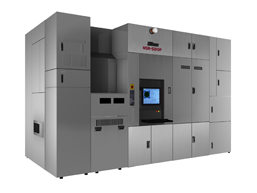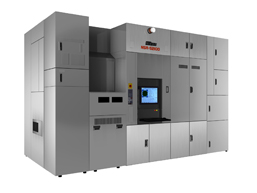Throughput improvement of 20% realized with Tandem StageNikon Announces New ArF Scanner – NSR-S310F and KrF Scanner – NSR-S210D
July 11, 2007
With a focus on leading-edge technology and high productivity, Nikon Corporation (Michio Kariya, President) announced their newest dry scanners for volume production, the NSR-S310F ArF scanner and the NSR-S210D KrF scanner. Both systems are built on the Tandem Stage platform, which was developed for Nikon's ArF immersion scanners and enables high productivity and enhanced alignment accuracy. Sales of the NSR-S310F system will start from the fourth quarter of 2007, and sales of the NSR-S210D system will start from the first Quarter of 2008.

ArF Scanner NSR-S310F

KrF Scanner NSR-S210D
Sales Summary
| Product name | Nikon ArF Scanner NSR-S310F Nikon KrF Scanner NSR-S210D |
|---|---|
| Sales launch term | Fourth Quarter, 2007 (NSR-S310F) First Quarter, 2008 (NSR-S210D) |
Development Background
VLSI chips, the foundation of the IT revolution, are becoming ever denser and the industry is now moving to the development of devices at the 45 nm node. Although most critical layers will be patterned with immersion lithography, some of the critical layers, and many of the less critical layers will be patterned with dry DUV scanners.
The NSR-S310F is the most advanced ArF scanner for high volume manufacturing of 65 nm or smaller devices. The system uses Nikon Tandem Stage technology to increase throughput, improve alignment accuracy, and enhance long-term stability. With the throughput increased to 174 wafers per hour – a 20% increase over the previous generation Nikon scanner – cost of ownership is significantly reduced. The Tandem Stage also helps improve alignment accuracy to better than 7 nm.
The projection optics (0.92 NA) and illumination system provide superior image quality and CD control across the wafer with the lowest aberration and flare levels in the industry. Nikon's fourth generation polarization control system, POLANO, and optional infrared aberration control (IAC) provide further imaging benefits.
The NSR-S210D with an NA of 0.82 is designed for patterning layers down to 110 nm. The system achieves 176 wafers per hour and 9 nm alignment accuracy.
With the introduction of the NSR-S310F and NSR-S210D systems, all Nikon scanners are now on a common platform. Having all scanner technologies on one platform enables manufacturing efficiencies, reduces cost over time, standardizes software across platforms, and simplifies field support. The Tandem Stage platform design will also reduce tool installation time, which is becoming increasingly important to device manufacturers.
"With the release of these new scanners Nikon has executed our strategy and introduced a complete new product lineup in the past year. In addition to migrating our entire scanner lineup to the high productivity Tandem Stage platform, we continued our technical leadership by shipping the world's first 1.30 NA immersion scanner in February, well before the competition," said Kazuo Ushida, President of the Precision Equipment Company, Nikon Corporation.
Main Performance Features
| NSR-S310F | NSR-S210D | |
|---|---|---|
| Resolution | 65 nm or better | 110 nm or better |
| NA (Numerical aperture) | 0.92 | 0.82 |
| Light source | ArF excimer laser (wavelength: 193 nm) | KrF excimer laser (wavelength: 248 nm) |
| Projection magnification | 1:4 | 1:4 |
| Maximum exposure field | 26 x 33 mm | 26 x 33 mm |
| Alignment accuracy | 7.0 nm or better (M + 3σ) | 9.0 nm or better (M + 3σ) |
| Throughput (300 mm wafers per hour) | 174 or more | 176 or more |
Main Characteristics
- High throughput, high accuracy using Nikon Tandem Stage technology
Nikon Tandem Stage technology uses an exposure stage and separate calibration stage for high throughput (174 wafers or more per hour) and high stability due to frequent calibration.
- Exceptional imaging
Nikon projection optics and illumination system provide superior imaging with low flare and insensitivity to thermal changes. The standard POLANO polarization technology and optional infrared aberration control (IAC) on the NSR-S310F provide further imaging benefits.
- Superior Cost-of-Ownership
The combination of production-proven imaging technology and the high throughput Tandem Stage deliver superior cost of ownership.
- The information is current as of the date of publication. It is subject to change without notice.
